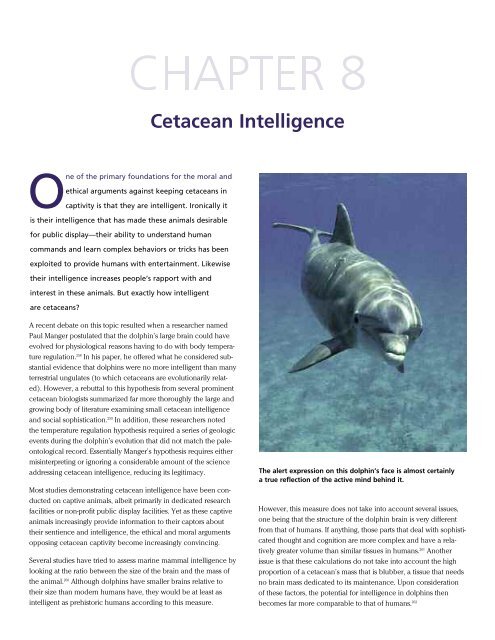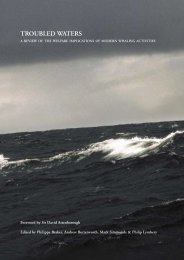Cetacean IntelligenceOne of the primary foundations for the moral andethical arguments <strong>aga<strong>in</strong>st</strong> keep<strong>in</strong>g cetaceans <strong>in</strong>captivity is that they are <strong>in</strong>telligent. Ironically itis their <strong>in</strong>telligence that has made these animals desirablefor public display—their ability to understand humancommands and learn complex behaviors or tricks has beenexploited to provide humans with enterta<strong>in</strong>ment. Likewisetheir <strong>in</strong>telligence <strong>in</strong>creases people’s rapport with and<strong>in</strong>terest <strong>in</strong> these animals. But exactly how <strong>in</strong>telligentare cetaceans?A recent debate on this topic resulted when a researcher namedPaul Manger postulated that the dolph<strong>in</strong>’s large bra<strong>in</strong> could haveevolved for physiological reasons hav<strong>in</strong>g to do with body temperatureregulation. 258 In his paper, he offered what he considered substantialevidence that dolph<strong>in</strong>s were no more <strong>in</strong>telligent than manyterrestrial ungulates (to which cetaceans are evolutionarily related).However, a rebuttal to this hypothesis from several prom<strong>in</strong>entcetacean biologists summarized far more thoroughly the large andgrow<strong>in</strong>g body of literature exam<strong>in</strong><strong>in</strong>g small cetacean <strong>in</strong>telligenceand social sophistication. 259 In addition, these researchers notedthe temperature regulation hypothesis required a series of geologicevents dur<strong>in</strong>g the dolph<strong>in</strong>’s evolution that did not match the paleontologicalrecord. Essentially Manger’s hypothesis requires eithermis<strong>in</strong>terpret<strong>in</strong>g or ignor<strong>in</strong>g a considerable amount of the scienceaddress<strong>in</strong>g cetacean <strong>in</strong>telligence, reduc<strong>in</strong>g its legitimacy.Most studies demonstrat<strong>in</strong>g cetacean <strong>in</strong>telligence have been conductedon captive animals, albeit primarily <strong>in</strong> dedicated researchfacilities or non-profit public display facilities. Yet as these captiveanimals <strong>in</strong>creas<strong>in</strong>gly provide <strong>in</strong>formation to their captors abouttheir sentience and <strong>in</strong>telligence, the ethical and moral argumentsoppos<strong>in</strong>g cetacean captivity become <strong>in</strong>creas<strong>in</strong>gly conv<strong>in</strong>c<strong>in</strong>g.Several studies have tried to assess mar<strong>in</strong>e mammal <strong>in</strong>telligence bylook<strong>in</strong>g at the ratio between the size of the bra<strong>in</strong> and the mass ofthe animal. 260 Although dolph<strong>in</strong>s have smaller bra<strong>in</strong>s relative totheir size than modern humans have, they would be at least as<strong>in</strong>telligent as prehistoric humans accord<strong>in</strong>g to this measure.<strong>The</strong> alert expression on this dolph<strong>in</strong>’s face is almost certa<strong>in</strong>lya true reflection of the active m<strong>in</strong>d beh<strong>in</strong>d it.However, this measure does not take <strong>in</strong>to account several issues,one be<strong>in</strong>g that the structure of the dolph<strong>in</strong> bra<strong>in</strong> is very differentfrom that of humans. If anyth<strong>in</strong>g, those parts that deal with sophisticatedthought and cognition are more complex and have a relativelygreater volume than similar tissues <strong>in</strong> humans. 261 Anotherissue is that these calculations do not take <strong>in</strong>to account the highproportion of a cetacean’s mass that is blubber, a tissue that needsno bra<strong>in</strong> mass dedicated to its ma<strong>in</strong>tenance. Upon considerationof these factors, the potential for <strong>in</strong>telligence <strong>in</strong> dolph<strong>in</strong>s thenbecomes far more comparable to that of humans. 262
<strong>The</strong> behavior of cetaceans also implies high <strong>in</strong>telligence; for example,bottlenose dolph<strong>in</strong>s are widely believed to possess <strong>in</strong>dividual,or signature, whistles, 263 which are thought to be important for <strong>in</strong>dividualrecognition or keep<strong>in</strong>g groups together. 264 Animals <strong>in</strong> thewild will make their specific whistles, which will be copied bynearby dolph<strong>in</strong>s. This is an example of dolph<strong>in</strong>s “address<strong>in</strong>g eachother <strong>in</strong>dividually,” 265 i.e., us<strong>in</strong>g the whistles <strong>in</strong> a way similar tohumans us<strong>in</strong>g names. Dolph<strong>in</strong>s are the only non-human animalsknown to communicate <strong>in</strong> such a way, which <strong>in</strong> itself is believedDolph<strong>in</strong> mothers are devoted to their offspr<strong>in</strong>g, teach<strong>in</strong>g themeveryth<strong>in</strong>g they need to know to survive and thrive. Photo:©2009 JUPITERIMAGES CorporationOrcas are the largest—and possibly the most <strong>in</strong>telligent andculturally varied—of the dolph<strong>in</strong> species. Photo: TatianaIvkovich, Far East Russia Orca Project (FEROP)to have been a key step <strong>in</strong> the evolution of human language. 266Similar calls, although not as obviously specific to <strong>in</strong>dividuals,have also been reported <strong>in</strong> comparable contexts <strong>in</strong> orcas. 267<strong>The</strong> complexity of cetacean communication has often been usedas a potential <strong>in</strong>dicator of <strong>in</strong>telligence, and a study exam<strong>in</strong><strong>in</strong>g thecomplexity of cetacean vocalizations discovered that the “communicationcapacity,” or the ability to carry <strong>in</strong>formation, of dolph<strong>in</strong>whistles is similar to many human languages. 268 This suggests thatcetaceans could potentially be speak<strong>in</strong>g their own language,which, as far as we currently know, would make them the onlyanimals besides humans to do so.In addition, research has shown that cetaceans have the capacityfor vocal learn<strong>in</strong>g. 269 Other research has demonstrated that bottlenosedolph<strong>in</strong>s can be taught to imitate computer-generatedsounds and to use these sounds to label or “name” objects. 270One of the most successful and illum<strong>in</strong>at<strong>in</strong>g cetacean l<strong>in</strong>guisticstudies 271 was conducted by Louis Herman, who taught bottlenosedolph<strong>in</strong>s a simple sign language and a computer-generated soundlanguage. 272 This study determ<strong>in</strong>ed that, us<strong>in</strong>g these artificialsymbolic languages, dolph<strong>in</strong>s could understand simple sentencesand novel comb<strong>in</strong>ations of words, but most importantly thatcetaceans comprehended sentence structure (syntax)—anadvanced l<strong>in</strong>guistic concept. Interest<strong>in</strong>gly, while we have beenable to teach dolph<strong>in</strong>s relatively sophisticated artificial languages,we have been unable to decode their many vocalizations, whichmay very well be a language. This begs the question of whichspecies is “smarter”—dolph<strong>in</strong>s, who can learn and understandwhat people want of them, or humans, who have yet to learnor understand what dolph<strong>in</strong>s might be tell<strong>in</strong>g us.Scientists have also shown that cetaceans are able to graspabstract concepts. 273 One of the most <strong>in</strong>trigu<strong>in</strong>g discoveries is thatdolph<strong>in</strong>s are able to discrim<strong>in</strong>ate between numbers of objects.Initial tests showed that dolph<strong>in</strong>s can, at the very least, dist<strong>in</strong>guishbetween a “few” and “many” objects 274 and numerically “less.” 275In his book <strong>The</strong> Ethics of Science, David Resnik highlights eightfactors potentially possessed by animals. <strong>The</strong> more of these factorsa species possesses, the more it should be considered morally andethically equivalent to humans. It could be argued that bottlenosedolph<strong>in</strong>s have demonstrated—or have demonstrated the potentialfor—at least seven of these eight factors, more than any otheranimal species.38
- Page 1 and 2: THE CASE AGAINSTMarine Mammalsin Ca
- Page 3 and 4: Authors: Naomi A. Rose, E.C.M. Pars
- Page 5 and 6: Public display facilities often pro
- Page 7 and 8: IntroductionWhen drafting the Marin
- Page 9 and 10: Education, Conservation, and Resear
- Page 11 and 12: habitat (known as in situ) or in ca
- Page 13 and 14: having a well-organized group is cr
- Page 15 and 16: took advantage of a period of gover
- Page 17 and 18: Unfortunately, captive facilities r
- Page 19 and 20: than this one), even when there are
- Page 21 and 22: Most cutting-edge behavioral resear
- Page 23 and 24: plans are often wholly inadequate).
- Page 25 and 26: sanitation methods that kill vegeta
- Page 27 and 28: A prime example of the inappropriat
- Page 29 and 30: Cetaceans are difficult to diagnose
- Page 31 and 32: allowed to enter the area and dolph
- Page 33 and 34: A detailed survey of public display
- Page 35 and 36: Curaçao. The facility tried to dow
- Page 37 and 38: The irony of the ocean beckoning ju
- Page 39 and 40: This dolphin has been fitted with a
- Page 41: The very traits that make dolphins
- Page 45 and 46: Most zoos and aquaria currently obt
- Page 47 and 48: Of at least 193 orcas held in capti
- Page 49 and 50: What replaces, with equal impact, p
- Page 51 and 52: only occurs in areas where there is
- Page 53 and 54: sions. This facility had already co
- Page 55 and 56: The Solomon Islands government has
- Page 57 and 58: S. R. Kellert and J. Dunlap, “Inf
- Page 59 and 60: in May 2006). When one considers th
- Page 61 and 62: paper, from 1954, could be found th
- Page 63 and 64: traits (e.g., docile disposition, s
- Page 65 and 66: cial and non-profit sponsors, and s
- Page 67 and 68: D. A. Carder, “Hearing deficits m
- Page 69 and 70: 154 Stereotypies are generally nega
- Page 71 and 72: y J. P. Schroeder entitled “Breed
- Page 73 and 74: Washington Legal Times, stating tha
- Page 75 and 76: about the welfare of the dolphins a
- Page 77 and 78: 251 Small and DeMaster, “Acclimat
- Page 79 and 80: Pinnipeds and Other Non-Cetaceans28
- Page 81 and 82: held for two years in a tank hidden
















